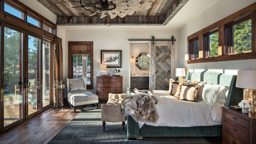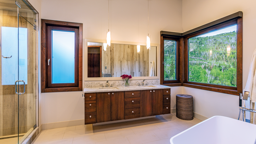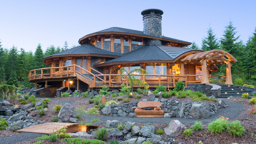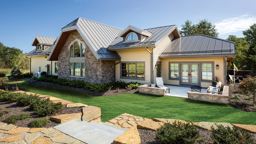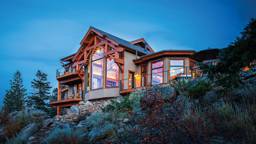
In time past, most people would typically stay in a house for seven to eight years before moving on to another home, either smaller or larger in size, depending on their family’s needs or job location.
But designers at many log and timber companies say that housing-progression philosophy has changed dramatically. With more people working from home exclusively, even young buyers are interested in planning and building their “forever home” now.
Designing a home that will be comfortable and accessible during each phase of life doesn’t require a crystal ball; it just demands of bit of forward thinking and a team that can help you finesse the details.
To ensure long-term functionality and satisfaction, here are the key elements designers are advising their clients consider.
Make the Basement Warm & Inviting
Regardless of the stage of life a person is in, designers recommend a full basement that’s warm and inviting with plenty of daylight. Consider these investments:
- Employ insulated concrete forms (ICFs) for basement sidewalls, with 9- or 10-foot sidewalls to add volume to the interior. ICFs provide a raft of advantages to homebuyers, including superior energy efficiency and speed of construction.
- Install large basement window wells, 53 inches wide and 72 inches deep, one each on the east and west sides of the home, and two on the south-facing side. This strategy will help to infuse daylight into this space and add egress.
- Add 4- to 6-inch rigid-foam insulation to the floor of the basement before pouring concrete to keep it comfortable during all four seasons.
- Add plumbing lines for another full bath, kitchenette and secondary laundry, even if you wouldn’t install these features until a later date. It’s easier and cheaper to pre-fit the space than to retrofit it.
Maximize Main-Floor Living for First-Time Buyers
- To keep costs down, embrace the cottage feel and keep square footage modest, around 1,000 to 1,200 square feet for the main floor. Draft an open floor plan for the kitchen, great room and dining space, with an additional two bedrooms and a full bath.
- Site the home so that should you need additional square footage in the future, you can easily remodel and add to either gable end of the home.
Anticipate a Growing, Blended or Extended Family
Perhaps you need a four-bedroom home for three children and a guest room/home office right now. As you look ahead 10, 20 or even 30 years, what will you be using that space for? Will you want home gym? His-and-her offices? A yoga studio perhaps?
Before committing to a specific floor plan, think through your options and how your circumstances will change over time, such as:
- Would it be better to have your children’s bedrooms in the basement, with a ground-level entrance rather than adding a second story?
- Would an outbuilding, such as a granny flat or ADU (additional dwelling unit), be the better option for a mother-in-law suite or visiting family members? Could you use it as a source of supplemental income by renting it, either long-term or as a vacation unit, in the future? Or, when the nest is empty, you could downsize to the ADU and rent out your larger home.
Live Happily Ever After Using Universal Design Principles
Accessibility is for everyone, from the youngest to the oldest. Employing simple design tweaks at the onset will help ensure you have a home that functions for all. These include:
- Installing 36-inch doorways and 5½-foot-wide hallways to accommodate wheelchairs or walkers.
- Avoiding stairs when possible; have at least one stair-free entry.
- Stack same-sized closets on each level, creating a shaft effect so that you have the option to add an elevator in the future without major remodeling.
- Create a main-floor primary bath oasis, equipped with a curbless (i.e., no raised threshold) shower, bench seating and a hand-held showerhead.
- Choose lever door handles rather than knobs, making it easier for those with diminished hand strength to operate.
Kitchen Design Strategies
Kitchens are where guests congregate and today’s family units (both nuclear and extended) spend the most time. Above all others, it’s the one room in the house that has to function the best. Use these universal design ideas to get the most out of your galley:
- Choose a microwave drawer rather than an over-the-stove microwave, which is harder for all to access.
- Specify lever handles for faucets or, even better, go touchless (for ease of use as well as keeping germs at bay).
- Opt for larger drawer handles and cabinet pulls, making them easier to grab.
- Plan a two-level kitchen island, so people can sit or stand when preparing food.
- Create wide berths around key kitchen workspaces because you never know when you might need more room for additional chefs.
Use these design strategies to design a new log, timber frame or hybrid home that you will love when you move in, as well as way into the future.




